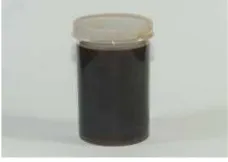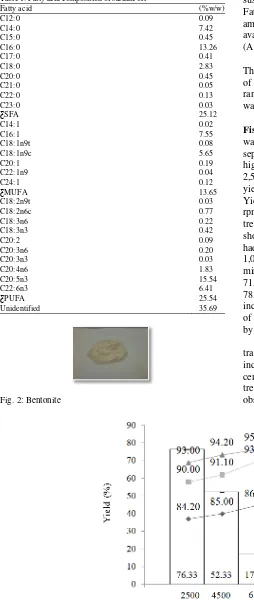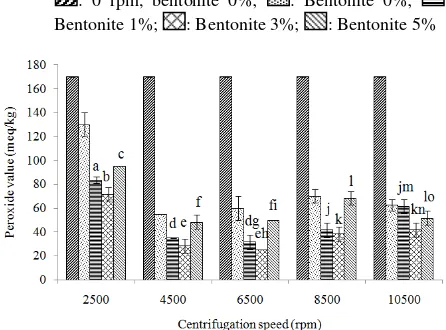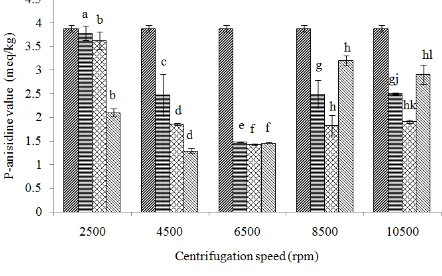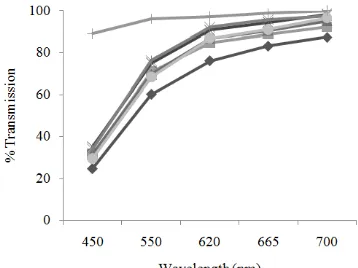Advance Journal of Food Science and Technology 6(1): 60-67, 2014 ISSN: 2042-4868; e-ISSN: 2042-4876
© Maxwell Scientific Organization, 2014
Submitted: August 24, 2013 Accepted: September 03, 2013 Published: January 10, 2014
Corresponding Author: S.H. Suseno, Department of Aquatic Products Technology, Bogor Agricultural University (Dramaga Campus), Jl. Agatis, Bogor, West Java, Indonisia, Tel.: (+62 251) 8622909-8622906; Fax: (+62 251) 8622907
Purification of
Sardinella
sp., Oil: Centrifugation and Bentonite Adsorbent
S.H. Suseno, Nurjanah, A.M. Jacoeb and Saraswati
Department of Aquatic Products Technology, Bogor Agricultural University (Dramaga Campus), Jl. Agatis, Bogor, West Java, Indonesia
Abstract: Centrifugation and purification using adsorbents is one example of a fish oil refining techniques applied to reduce impurities of fish oil. The study aimed to determine the sardine oil quality before treatment, to determine yield of fish oil after centrifugation treatment and to determine the influence of centrifugation speed and bentonite concentration on sardine oil quality. Factorial design with two factors was used in this study. Level of free fatty acid and peroxide value before purification was 35.53% and 170 mEq/kg. Yield of fish oil after centrifugation treatment has been ranged from 17.42±3.56 to 76.33±0.21%. The best treatment which could reduce the peroxide value and total oxidation was a treatment with centrifugation speed at 6500 rpm and bentonite concentration at 3%. Peroxide value and total oxidation of its treatment was 25.00±0.00 and 51.43±0.01 mEq/kg. The lowest value of p-anisidine was 1.29±0.05 mEq/kg and its value could be found in a treatment with centrifugation speed at 4500 rpm and bentonite concentration at 5%. The level of free fatty acid after purification process was ranged from 27.35 to 34.69%. Oil clarity tended to increase with the increase of centrifugation speed and adsorbent concentration.
Keywords: Bentonite, centrifugation, fish oil, purification, Sardinella sp., yield
INTRODUCTION
Fish oil which produced by fish meal industry has a lower quality than fish oil that obtained from the fish canning process, especially if we compare in terms of color, free fatty acid levels and peroxide value. Unrefined fish oil, as fish meal industry by product, has a darker color, higher peroxide value and higher free fatty acid levels (Ahmadi and Mushollaeni, 2007). High level of free fatty acid may inhibit fish oil utilization.
The crude fish oil is a mixture of several compounds such as glycerides, free fatty acids, phospholipids, sterols, tocopherols, pigments and toxic substances (e.g., heavy metals dioxins or PCBs) (Cheryan, 1998). Therefore, the purpose of oil refining is to remove impurities such as non-triglyceride compounds, colorants and smelly and toxic substances to produce high quality edible oils suitable for human consumption. Methods currently in use in refining crude fish oil are chemical or physical in nature. The conventional fish oil refining practised in industry is usually chemical-based. The chemical refining method involves distinct stages such as degumming (to separate phospolipid), neutralizing (to clear free fatty acid and decrease oil acidity), bleaching (to adsorb contaminants and pigment) and deodorization (to remove smelly compounds). On the other hand, physical refining involves degumming, bleaching and steam distillation (to remove free fatty acids and volatile compounds).
An alternative method for improving the quality of sardine oil is to remove impurities using adsorbents.
Several oil refining experiments using adsorbents were previously performed by Bhattacharya et al. (2008), Sabah and Celik (2005), Giiler and Fatma (1992) and Lin et al. (1998). Those researchers reported positive results for edible oil refining using this method. Setiawan (1997) stated that bentonite is one of the local minerals that are abundant in nature and can be utilized for various purposes. Foletto et al. (2006) found that bentonite adsorbents can be used in the process of bleaching or refining oil as bleaching earth, because of high content of montmorillonite. In addition, Byrne (2001) stated that montmorillonite, a type of aluminum silicate hydrate with its main elements, among others: silicate, aluminum, oxygen and the hydroxyl group.
Fish oil refining research using natural and synthetic adsorbents is still limited, but this method has a great potential due to its simple process and the use of available manufacturing facilities. This study aimed to determine the characteristics of unrefined sardine oil and bentonite that were used in the purification of fish oil, yield of fish oil after centrifugation at 2,500, 4,500, 6,500, 8,500 and 10,500 rpm and to determine the effect of centrifugation speed and bentonite adsorbent concentration on the quality of sardine oil.
MATERIALS AND METHODS
Adv. J. Food Sci. Technol., 6(1): 60-67, 2014
characterization and analysis of quality of fish oil were needed. Some tools such as erlenmeyer glass, aluminum foil, magnetic stirrer, magnetic stirring bar, stop watch, digital scales, pipette, eppendorf tube size 80 and 500 mL and a high-speed refrigerated centrifuge himac brand HITACHI CR 21G were used for refining process. The other supporting tools and instruments for quality analysis of fish oil were used.
Scope of research: This study was consisted of two main phases, namely the characterization of sardine oil and adsorbent and determination of factors that influence fish oil purification process. Characterization of sardine oil includes analysis of fatty acid composition, peroxide value and free fatty acid level of unrefined fish oil. The characterization of bentonite in terms of color, shape and size was done.
Randomized factorial design with two factors was used as experimental design. Level of centrifugation speed that conducted in this study was 2,500, 4,500, 6,500, 8,500 and 10,500 rpm. Adsorbent concentration that used in further purification process was 1, 3 and 5% (%w/w). Three replicates were performed on each experimental design. Fish oil quality parameters (responses) were observed including level of free fatty acid, peroxide value, p-anisidin value, total oxidation and level of fish oil clarity.
Fish oil purification: Unrefined fish oil was prepared and weighed as required, then it was centrifuged at a speed that has been determined to separate impurities and soap stock in fish oil. Formed part of supernatant was taken and weighed to obtain the yield of the centrifugation process. Fish oil was then tested as free fatty acid level, peroxide value and oil clarity level, before further refining of fish oil using adsorbent.
Fish oil that has been refined through centrifugation step was then purified using adsorbent based on a predetermined concentration. Purification using the adsorbent was done by stirring the mixture of fish oil and bentonite continuously using magnetic stirrer for 20 min at room temperature (±29°C), then a mixture of fish oil and bentonite was separated by centrifuging at 10,000 rpm for 10 min at a temperature of 10°C. Fish oil that has been separated from the adsorbent was stored in a container which wrapped in aluminum foil and stored at ±4°C until analysis of quality fish oil was conducted.
Analysis of fish oil quality: Some analysis that
conducted in this study were determination the yield of refined fish oil after centrifugation, analysis of fatty acid composition using gas chromatography (AOAC, 2005, method no. 969.33), analysis of free fatty acid level (AOCS, 1998, method no. Ca 5a-40), analysis of peroxide value (AOAC, 2000, method no. 965.33b), analysis of p-anisidine value (IUPAC, 1987), method no. 2504), determination of the of total oxidation/ TOTOX (AOCS, 1997) and oil clarity test (AOAC, 1995 with modification, method no. 955.23).
Data analysis: Randomized factorial design with two factors was used as experimental design. Responses value as results then processed statistically using statistical software (PASW 18.0) to see the regression parameter coefficients, percent significance (confidence interval) and the pattern of interaction of factors that significantly influence the response.
RESULTS AND DISCUSSION
Sardine fish oil characteristics and type of adsorbent: This unrefined sardine oil had a brownish black color with a fishy smell. Its free fatty acid level and peroxide value was 35.53% and 170 mEq/kg, respectively. This value exceeds maximum levels of free fatty acids and peroxide value based on IFOS (2011). Fish oil that wants to be consumed may not exceed 1.5% for free fatty acid and 5 meq/kg for peroxide value. The sardine oil which was observed can be seen in Fig. 1.
Fish oil which produced by fish meal processing typically has a lower quality than fish oil from canned fish processing. It is marked by a darker color and higher free fatty acid than fish oil which produced by canned fish industry. Fish oil with a high peroxide indicates that the oil is not processed and stored in the correct manner, so it can cause excessive oxidation. High level of free fatty acid may be due to the thermal process which allows faster hydrolysis of fish oil and high water content causes faster hydrolysis process too (Irianto and Giyatmi, 2009). Raw material of fish meal generally comes from rejected fish, fish viscera and fish heads that are not fresh. The raw materials can suffer damage including fats breakdown that can lead to increase level of free fatty acid (Estiasih, 2009).
Result of fatty acid composition analysis in the observed sardine oil can be seen in Table 1. Fatty acid composition analysis results indicated that the observed sardine oil contains Saturated Fatty Acid (SFA) at 25.12%, Monounsaturated Fatty Acid (MUFA) at 13.65% and Polyunsaturated Fatty Acids (PUFA) at 25.54%. EPA was highest content of fatty acid; its value was 15.54%. These results indicated that fatty acid content of fish oil sardines dominated by polyunsaturated fatty acids, so it is related to the
Adv. J. Food Sci. Technol., 6(1): 60-67, 2014
Table 1: Fatty acid composition of sardine oil
Fatty acid (%w/w)
C12:0 0.09
C14:0 7.42
C15:0 0.45
C16:0 13.26
C17:0 0.41
C18:0 2.83
C20:0 0.45
C21:0 0.05
C22:0 0.13
C23:0 0.03
ƸSFA 25.12
C14:1 0.02
C16:1 7.55
C18:1n9t 0.08
C18:1n9c 5.65
C20:1 0.19
C22:1n9 0.04
C24:1 0.12
ƸMUFA 13.65
C18:2n9t 0.03
C18:2n6c 0.77
C18:3n6 0.22
C18:3n3 0.42
C20:2 0.09
C20:3n6 0.20
C20:3n3 0.03
C20:4n6 1.83
C20:5n3 15.54
C22:6n3 6.41
ƸPUFA 25.54
Unidentified 35.69
Fig. 2: Bentonite
susceptibility of fish oil to undergo oxidative rancidity. Fat content and fatty acid composition in fish vary among species of fish, fish sex, age of fish, season, food availability, salinity and temperature environments (Ackman, 1988).
Adsorbent which used in this study was bentonite. This adsorbent has a brownish-yellow color, the shape of this adsorbent was powder and it had a particle size ranged 100-180 mesh. Physical appearance of bentonite was used as an adsorbent can be seen in Fig. 2.
Fish oil yield after centrifugation: Unrefined fish oil was treated by centrifugation at various speeds to separate the soap stock that contained in fish oil. The highest value of centrifugation yield was treatment with 2,500 rpm as centrifugation speed, while the lowest yield values contained in the treatment 6,500 rpm. Yield occurred impairment from 2,500 towards 6,500 rpm treatment, then the yield of fish oil increased at treatment of 8,500 and 10,500 rm. Suseno et al. (2011) showed that the yield percentage of neutral fish oil that had been separated using centrifuge at various speed of 1,000, 5,000, 10,000, 15,000 and 18,000 rpm for 15-20 min separation was 47.00 to 52.00%, 62.00 to 77.00%, 71.20 to 81.19%, 73.10 to 82.53% and 77.94 to 78.53%, respectively. The results showed that the increase of centrifugation speed implied on the increase of fish oil yield. Yield values were strongly influenced by the homogenity of the sample to be separated.
Line graph in Fig. 3 which shows the percent light transmission on sardine oil indicated that there was an increase in light transmission with increasing of centrifugion speed. It shows that the centrifugation treatment can improve the clarity of the fish oil was observed.
Adv. J. Food Sci. Technol., 6(1): 60-67, 2014
DETERMINATION OF THE EFFECT OF CENTRIFUGATION SPEED AND ADSORBENT CONCENTRATION
ON SARDINE OIL QUALITY
Free fatty acid: Free Fatty Acids (FFA) are formed as a consequence of Triacylglycerol (TAG) hydrolysis. Crude fish oil can contain FFA up to 12% (as oleic acid) of total fatty acid but typical values are lower, in the range of 1-7% and usually 2-5% (Bimbo, 1998). Free fatty acid levels tended to decrease after getting treatment of purification. It can be seen in Fig. 4. Purification treatment can also cause minor constituents such as tocopherols or other types of natural antioxidants contained in the oil can be reduced, so they can affect decreasing of oxidative stability and increasing levels of free fatty acid. Tocopherol acts as natural antioxidants that protect the quality of the oil from rancidity (Roy, 1978).
Lowest level of free fatty acids contained in the treatment of 8,500 rpm with bentonite concentration of 5%, which was 27.35±0.00%. ANOVA results showed that the centrifugation speed, adsorbent concentration and the interaction between centrifugation speed and adsorbent concentration affects the levels of sardine oil free fatty acid (p<0.05). Linear equations model of free fatty acids adsorption process was y = 41,704.63 + 205.37x1 + 6.71x2 + 12.96x1x2, which y was a free fatty acid level as the response variable, x1 was centrifugation speed and x2 was the concentration of adsorbent bentonite. R2 value of the equation was 0.99, while the value of the error of the equation was 2.65. The result of above analysis showed that combination treatment between centrifugation and purification using adsorbent could reduce the level of free fatty acid which was ranged 2.36 to 23.02%. Suseno et al. (2011) showed that combination treatment of 5,000 rpm as centrifugation speed and magnesol 1% could reduce levels of free fatty acids up to 91.05%. Different types of adsorbents will have some differences of physicochemical characteristics, such as a polarity, the active surface, surface area, porosity, particle size, pH and water content (Zhu et al., 1994).
Yates et al. (1997) suggested that triglyceride and oleic acid were physically adsorbed by synthetic magnesium silicate through hydrogen-bonding of the carbonyl group to Surface Silanols (Si-OH). Oleic acid was also chemically adsorbed via ionic bond between carboxylate ion (COO-) and metal oxide on the surface.
Peroxide value: The result which can be seen in Fig. 5 showed that combination treatment could reduce the peroxide value effectively, if it was compared with centrifugation treatment only. The increasing of bentonite concentration from 1 to 3% of each centrifugation speed could reduce peroxide value, whereas combination treatment between centrifugation
Fig. 4: Free fatty acid level of sardine oil before and after purification
: 0 rpm, bentonite 0%; : Bentonite 0%; : Bentonite 1%; : Bentonite 3%; : Bentonite 5%
Fig. 5: Peroxide value of sardine oil before and after purification
: 0 rpm, bentonite 0%; : Bentonite 0%; : Bentonite 1%; : Bentonite 3%; : Bentonite 5%
speed and adsorbent concentration of 5% could increase the peroxide value. High adsorbent concentration may allow adsorption of impurities occurs maximally, but it allows the natural antioxidants contained in the pigment to be adsorbed and it can affect the instability on fish oil. Purification using process using bleaching earth can adsorb up to half of the natural antioxidants in oil (Patterson, 2009). According to Dimic et al. (1994) the bleaching process was considered particularly undesirable, as large amounts of bleaching earth promote a loss of tocopherols, further affecting the oil stability. In addition, List et al. (1972) also reported that sunflower oils treated in the laboratory with a high concentration of bleaching earth (6%) had poorer flavor and oxidative stability than the same oil bleached with a lower concentration of earth (2%). Apparently bleaching removes, destroys or inactivates some unknown minor constituent essential for optimum keeping qualities.
Adv. J. Food Sci. Technol., 6(1): 60-67, 2014
concentration of 3%, while its peroxide value was 25 mEq/kg. Reduction of peroxide value was ranged from 50.98 to 85.29% and the peroxide value on unrefined fish oil was 170 mEq/kg. Palanisamy et al. (2011) showed that the bentonite was able to reduce peroxides on ostrich oil up to 93.9 with 10% bentonite concentration and adsorption performed for 70 min. Differences in the effectiveness of peroxide reduction may be caused by differences in the sample to be purified, the length of the adsorption process, adsorption temperature and concentration of adsorbent used (Patterson, 2009).
ANOVA result showed that the centrifugation speed, adsorbent concentration and the interaction between centrifugation speed and adsorbent concentration affected the peroxide value of sardine oil (p<0.05). Linear equation model of peroxide adsorption process in sardine oil was y = 119,093.89 + 13,281.11x1 + 3,534.44x2 + 1,132.22x1x2, which y was peroxide value as the response variable, x1 was the centrifugation speed and x2 was the bentonite concentration. R2 value of the equation was 0.96, while the error value of equation was 683.33.
Adsorption process of impurities that may occur in the sardine oil refining is the process of bonding based on physical adsorption, where it is related to the configuration of bentonite constituent molecules. Physical bonding occurs due to van der Waals forces between the molecules which are formed on the adsorbent bentonite with the impurity molecules (adsorbate). Characteristics of physical adsorption process are the adsorption process is only carried out at temperatures below 100°C, the bond that is formed between the adsorbent and adsorbate is quite weak and physical bond that is formed is reversible (Patterson, 2009). This sardine oil refining is only performed at room temperature, so it causes the possible adsorption mechanism is physical adsorption.
Syuhada and Jayatin (2009) stated that the bentonite is montmorillonite clay, whose contains up to 80% of montmorillonite. Bentonite layer structure consisting of silica, alumina and monovalent and bivalent cations located between the layers of silica and alumina. The molecular configuration allows the bentonite can be used as an adsorbent that is quite effective to adsorb impurities in the fish oil component. Surface area of the porous support the performance of bentonite as adsorbent that can absorb impurities.
P-anisidine value:The amount of secondary oxidation products is determined by the anisidine value (Guillen and Cabo, 2002). P-anisidine value reduction occurred after the combination purification treatment. The result of p-anisidine value analysis can be seen in Fig. 6. Highest p-anisidine value found in control sample and sample that was subjected to centrifugation speed of 2,500 rpm with 1% bentonite. The lowest p-anisidine
Fig. 6: P-anisidine value of sardine oil before and after purification
: 0 rpm; bentonite 0%; : Bentonite 1%; : Bentonite 3%; : Bentonite 5%
value presented in sample with the treatment of 4,500 rpm as centrifugation speed and 5%, its value was 1.29±0.05 mEq/kg. All p-anisidine values which were detected in all samples were still lower than the standard set by IFOS (2011) (15 meq/kg). P-anisidine value is not always in line with the high value of peroxide (Guillen and Cabo, 2002), but the high value of peroxide can cause high value of p-anisidine if the process given allowing fish oil to go further degradation. Reduction of p-anisidine value was ranged from 2.57 to 66.75%.
ANOVA result showed that centrifugation speed, adsorbent cocnentration and interaction between centrifugation speed and adsorbent concentration affected sardine oil’s p-anisidine value (p<0.05). Linear equation model of secondary oxidation compound adsorption process in sardine oil was y = 236.17 + 15.43x1 + 1.46x2 + 10.14x1x2, which y was p-anisidine value as the response variable, x1 was the centrifugation speed and x2 was the concentration of adsorbent bentonite. R-square value of the equation was 0.97, while the error value of equation was 0.91.
Total oxidation: Total Oxidation (TOTOX) is the sum of the peroxide value and p-anisidine value. The total oxidation can be used to measure the progression of deterioration that occurs in oil and provide information on the formation of primary and secondary oxidation products (Hamilton and Rossell, 1986). Total oxidation of each treatment can be seen in Fig. 7.
Adv. J. Food Sci. Technol., 6(1): 60-67, 2014
Fig. 7: Total oxidation value of sardine oil before and after purification
: 0 rpm, bentonite 0%; : Bentonite 1%; : Bentonite 3%; : Bentonite 5%
Fig. 8: Percentage of light transmission to sardine oil before and after purification using treatment of centrifugation speed and 1% bentonite
: 0 rpm, 0% bentonite; : 2.500 rpm; : 4.500 rpm; : 6.500 rpm; : 8.500 rpm; : 10.500 rpm; : Commercial product
Fig. 9: Percentage of light transmission to sardine oil before and after purification using treatment of centrifugation speed and 3% bentonite
: 0 rpm, 0% bentonit: : 2.500 rpm; : 4.500 rpm; : 6.500 rpm; : 8.500 rpm; : 10.500 rpm; : Commercial product
ANOVA result showed that centrifugation speed, adsorbent concentration and interaction between centrifugation speed and adsorbent concentration
Fig. 10: Percentage of light transmission to sardine oil before and after purification using treatment of centrifugation speed and 5% bentonite
: 0 rpm, 0% bentonit; : 2.500 rpm; : 4.500 rpm; : 6.500 rpm; : 8.500 rpm; : 10.500 rpm; : Commercial product
affected total oxidation of sardine oil (p<0.05). Linear equation model of the relationship between the total oxidation and factors in this process was y = 497,825.35 + 54,826.73x1 + 14,157.96x2 + 4,534.21x1x2, which y was total oxidation as response variable, x1 was centrifugation speed and x2 was bentonite concentration. R2 value of the equation was 0.96, while error value of equation was 2,736.64.
Clarity: The result that can be seen in Fig. 8 to 10 showed that treatment of centrifugation which added by addition of bentonite can lead to increase in percentage of light transmission to the fish oil at various wavelengths tested. Combination treatment in oil refining can reduce levels of free fatty acids, primary and secondary oxidation products of the oil. This implied an increase in clarity after fish oil was purified.
Figure 10 shows that the decrease in the value of the transmission occurs at the 10,500 rpm with 5% bentonite treatment. Downward trend in percentage of light transmission was inversely proportional to the trend of increase in peroxide value, p-anisidine value and total oxidation at treatment of 10,500 rpm and 5% bentonite. Primary and secondary oxidation products are likely to affect the color and turbidity of fish oil, if there is a higher content of primary and secondary oxidation products in fish oil, the appearance of the observed fish oil will be dark, so level of clarity tends to decrease (Estiasih, 2009). Percentage of light transmission value of the oil sardine at a wavelength of 620, 665 and 700 nm, respectively was ranged from 84.63 to 99.23%.
CONCLUSION
Adv. J. Food Sci. Technol., 6(1): 60-67, 2014
which was used has the form of a powder, brownish yellow color and about 100-180 mesh size.
Highest fish oil yield could be found in 2,500 rpm centrifugation treatment and its value was 76.33±0.21%. The lowest yield value contained in the 6,500 rpm treatment was 17.42±3.56%. The best treatment to get lowest content of primary oxidation and total oxidation was purification treatment of 6500 rpm and 3% bentonite. The best treatment to get the lowest-anisidine value was a treatment of 4,500 rpm and 5% bentonite. Lowest levels of free fatty acids contained in the treatment of 8,500 rpm with 5% bentonite. Percentage of light transmission to sardine oil at a wavelength of 620, 665 and 700 nm, respectively was ranged from 84.63 to 99.23%.
ACKNOWLEDGMENT
This study completion would not have been possible without the assistance of many people who gave their support. To them I would like to convey my heartfelt gratitude and sincere appreciation.
REFERENCES
Ackman, R.G., 1988. Concerns for utilization of marine lipids and oils. Food Technol., 42(5): 151-155. Ahmadi, K. and W. Mushollaeni, 2007. Chemical
activation of natural zeolite alam for refining of fish oil as by product of sardine (Sardinella longiceps) fish meal industry. J. Teknologi Pertanian, 8(2): 71-79.
AOAC, 1995. Official Methods of Analysis of The Association of Official Analytical Chemist. AOAC Inc., Washington, US.
AOAC, 2000. Official Methods of Analysis of the Association of Official Analytical Chemist. 17th Edn., AOAC Inc., Washington. US.
AOAC, 2005. Official Method of Analysis of the Association of Official Analytical of Chemist. AOAC Inc., Virginia, US.
AOCS, 1997. Official Methods and Recommended Practices of the American Oil Chemists' Society. Official Method cd 8-53 Peroxide Value, cd18-90 p-ansidine Value, cg 3-91 Recommended Practices for Assessing Oil Quality and Stability. AOCS Press, Urbana, US.
AOCS, 1998. Official Methods and Recommended Practices of the American Oil Chemists Society. 5th Edn., AOCS Press, Champaign, US.
Bhattacharya, B.A., M.G. Sajilata, S.R. Tiwari and R.S. Singhal, 2008. Regeneration of thermally polymerized frying oils with adsorbents. Food Chem., 110: 562-570.
Bimbo, A.P., 1998. Guidelines for characterizing food-grade fish oils. Inform. Int. News Fats Oils Relat. Mater., 9(5): 473-483.
Byrne, D., 2001. Specific purity criteria on food additives other than colours and sweeteners. Official J. Eur. Commun., Brussels.
Cheryan, M., 1998. Ultrafiltration and Microfiltration Handbook. 2nd Edn., Technomic Pub. Lancaster, Pa.
Dimic, E., D.J. Karlovic and J. Turkulov, 1994. Pretreatment efficiency for physical refining of sunflowerseed oil. J. Am. Oil Chem. Soc., 71: 1357-1361.
Estiasih, T., 2009. Fish Oil: Technology and Implementation for Food and Health. Graha Ilmu, Yogyakarta (ID).
Foletto, E.L., C. Volzone and L.M. Porto, 2006. Clarification of cottonseed oil: How structural properties of treated bentonites by acid affect bleaching efficiency. Lat. Am. Appl. Res., 36(2006): 37-40.
Giiler, E. and T. Fatma, 1992. Chlorophyll adsorption on acid-activated clay. J. Am. Oil Chem. Soc., 69(9): 948-950.
Guillen, M.D. and N. Cabo, 2002. Fourier transform infrared spectra data versus peroxide and anisidine values to determine oxidative stability of edible oils. Food Chem., 77: 503-510.
Hamilton, R.S. and J.B. Rossell, 1986. Analysis of Oils and Fats. Elsevier Applied Science, London, pp: 23-32.
IFOS (International Fish Oils Standard), 2011. Fish Oil Purity Standards. Retrieved form: http:// www. omegavia. com/best- fish- oil- supplement-3/. (Accessed on: June 27, 2013).
Irianto, H.E. and S. Giyatmi, 2009. Fish Processing Technology. Universitas Terbuka, Jakarta (ID). IUPAC, 1987. Standard Methods for the Analysis of
Oils Arld Fats and Derivative. In: Paquot, C. and A. dan Hautfenne (Eds.), 7th Edn., Blackwell Scientific, Oxford (GB).
Lin, S., C.C. Akoh and A.E. Reynolds, 1998. The recovery of used frying oils with various adsorbents.J. Food Lipids, 5: 1-16.
List, G.R., C.D. Evans and H.A. Moser, 1972. Flavor and oxidative stability of northern-grown sunflower seed oil. J. Am. Oil Chem. Soc., 49: 287-292.
Palanisamy, U.D., M. Sivanathan, A.K. Radhakrishnan, N. Haleagrahara, T. Subramaniam and G.S. Chiew, 2011. An effective ostrich oil bleaching technique using peroxide value as an indicator. Molecules, 16: 5709-5719.
Patterson, H.B.W., 2009. Adsorption. In: List, G.R. (Ed.), Bleaching and Purifying Fats and Oils. AOCS Press, US.
Adv. J. Food Sci. Technol., 6(1): 60-67, 2014
Sabah, E. and M.S. Celik, 2005. Sepiolite: An effective bleaching adsorbent for the physical refining of degummed rapeseed oil. J. Am. Oil Chem. Soc., 82: 911-916.
Setiawan, B., 1997. Bentonite: Clay environment savior. Indones. Waste Bull., 2(2): 21-25.
Suseno, S.H., A.Y. Tajul and N.W.A. Wan, 2011. The use of passive filtration for optimization of magnesol xl function for improving the quality of Sardinella lemuru oil. Int. Res. J. Biochem. Bioinform.,1(5): 103-113.
Syuhada, R.W. and S.R. Jayatin, 2009. Modification of bentonite (clay) to be organically with added by surfactan. J. Nanosains Nanoteknologi, 2(1): 48-51. Yates, R.A., J.D. Caldwell and E.G. Perkins, 1997.
Diffuse reflectance fourier transform infrared spectroscopy of triacylglycerol and oleic acid adsorption on synthetic magnesium silicate. J. Am. Oil Chem. Soc., 74: 289-292.
